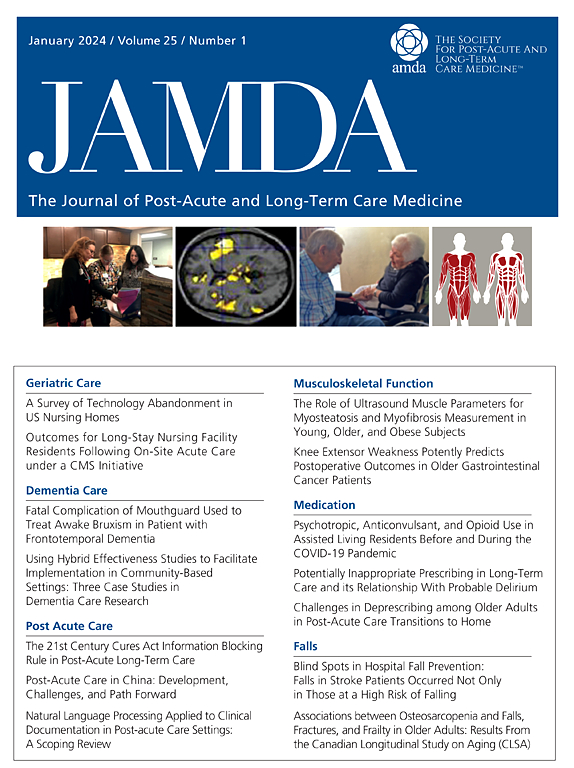成功的护理会议:养老院工作人员,痴呆症患者和护理人员的观点。
IF 4.2
2区 医学
Q2 GERIATRICS & GERONTOLOGY
Journal of the American Medical Directors Association
Pub Date : 2025-03-03
DOI:10.1016/j.jamda.2025.105504
引用次数: 0
摘要
目的:本研究的目的是确定疗养院(NH)虚拟护理会议的最佳实践,使用Me & My wishes -记录居民护理偏好的视频,包括那些患有阿尔茨海默病和相关痴呆症的人。在护理会议期间,与护理伙伴和工作人员分享视频,以确保所提供的护理符合居民的愿望,特别是在他们接近生命尽头的时候。设计:采用定性描述性设计,涉及焦点小组,提供三个群体(痴呆症患者、NH工作人员和护理伙伴)的观点,以确定在虚拟护理会议中成功举办护理会议的因素。环境和参与者:采用方便抽样的方法从不同地理位置招募焦点小组参与者(即社区顾问)。通过与社区伙伴团体建立的关系,促进了征聘工作。顾问包括NH领导人,社区居住的老年人和护理伙伴。方法:于2023年2月至6月进行了6次虚拟焦点小组会议。在使用“我和我的愿望”干预时,使用半结构化指南来确定成功的虚拟护理会议的关键因素。会议记录,转录,并使用内容分析进行分析。结果:确定了成功的虚拟护理会议的三个领域。它们是由居民驱动的、吸引人的、有组织的。他们包括最熟悉住院医生的跨学科护理团队成员,优先考虑住院医生的需求和偏好,以确保他们是讨论的中心,并鼓励住院医生和护理伙伴积极参与。最后,护理会议由训练有素的主持人主持,整个跨学科护理团队接受关于主持和参与护理会议的培训,包括提供技术支持,以最大限度地提高住院医生和护理伙伴的参与度。结论和启示:成功的护理会议,无论是面对面的还是虚拟的,都需要结构化的方法,优先考虑住院医生的参与,并包括最了解住院医生的人。本文章由计算机程序翻译,如有差异,请以英文原文为准。
Successful Care Conferences: Nursing Home Staff, Persons with Dementia, and Caregiver Perspectives
Objectives
The objective of this study was to identify best practices for nursing home (NH) virtual care conferences using Me & My Wishes—videos that document care preferences of residents, including those living with Alzheimer's disease and related dementias. Videos are shared during care conferences with care partners and staff to ensure that the care provided aligns with the resident's wishes, especially as they approach the end of life.
Design
A qualitative descriptive design involving focus groups providing the perspective of 3 groups (people living with dementia, NH staff, and care partners) was used to determine what makes a successful care conference when the care conference is conducted virtually.
Setting and Participants
Convenience sampling was used to recruit focus group participants (ie, community advisors) from various geographic locations. Recruitment was facilitated through established relationships with community partner groups. Advisors included NH leaders, community-dwelling older adults, and care partners.
Methods
Six virtual focus group sessions were conducted from February to June 2023. A semistructured guide was used to identify key factors of successful virtual care conferences when using the Me & My Wishes intervention. Sessions were recorded, transcribed, and analyzed using content analysis.
Results
Three domains for successful virtual care conferences were identified. They are resident-driven, engaging, and structured. They include interdisciplinary care team members most familiar with the resident, prioritize the needs and preferences of residents to ensure they are central to the discussion, and encourage active participation of residents and care partners. Finally, care conferences are led by trained facilitators, with the entire interdisciplinary care team receiving training on conducting and participating in care conferences, including providing technology support to maximize resident and care partner engagement.
Conclusions and Implications
Successful care conferences, whether in-person or virtual, require structured approaches that prioritize resident involvement and include people who know the resident best.
求助全文
通过发布文献求助,成功后即可免费获取论文全文。
去求助
来源期刊
CiteScore
11.10
自引率
6.60%
发文量
472
审稿时长
44 days
期刊介绍:
JAMDA, the official journal of AMDA - The Society for Post-Acute and Long-Term Care Medicine, is a leading peer-reviewed publication that offers practical information and research geared towards healthcare professionals in the post-acute and long-term care fields. It is also a valuable resource for policy-makers, organizational leaders, educators, and advocates.
The journal provides essential information for various healthcare professionals such as medical directors, attending physicians, nurses, consultant pharmacists, geriatric psychiatrists, nurse practitioners, physician assistants, physical and occupational therapists, social workers, and others involved in providing, overseeing, and promoting quality

 求助内容:
求助内容: 应助结果提醒方式:
应助结果提醒方式:


